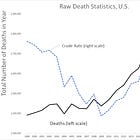Geeking Out: Querying the Multiple Cause of Death Database in CDC WONDER
A How-To Video with comparisons
Recently, somebody asked me a question about querying CDC WONDER on the Multiple Causes of Death.
I usually don’t use that area of query, because it’s so much simpler to focus on the single Underlying Cause of Death per death certificate. But to help those who want to use the database, here is a demo showing the distinction between querying any death certificate that has any of two causes of death (as in cancer OR heart disease, anywhere on the death certificate) or has both of the causes.
Let’s look at the numbers quickly for comparisons.
Top Two Causes of Death, Total Deaths, and Multiple Causes of Death
In the video, I focused solely on the multiple causes of death aspect, and how one could combine different causes.
Let me expand on what I demonstrated above with the two specific causes mentioned: cancer (aka malignant neoplasms [C00-C97]) and heart disease (aka diseases of heart [I00-I09,I11,I13,I20-I51]).
I will look at 2018 - 2023, where the 2023 data is provisional.
Count
This is the simple count, so you can see the different amounts.
Underlying cause of death is one and only one per death certificate.
For multiple causes of death, up to 20 can be listed.
More here:
Percentage of Total Deaths
In transforming these to the percentage of total deaths, we see that in the pre-pandemic years of 2018-2019, 44% of deaths had cancer or heart disease as their underlying cause of death.
But 63% of death certificates had cancer or heart disease somewhere on the death certificate in those years.
[This dropped in pandemic years, as COVID “stole share” from the main causes of death.]
Whether pre-pandemic or post-pandemic, only about 5% of deaths involved both cancer and heart disease.
Cancer and heart disease are obviously involved in plenty of deaths, though not necessarily listed as the underlying cause of death.
For example, the underlying cause of death could be listed as diabetes, but have heart disease as a contributing cause of death. I imagine that would be fairly common with the rise in obesity.
Be Careful with Multiple Causes of Death
People have queried CDC WONDER, and, when not happy with the results that the underlying cause of death queries got them, decided to dip into the multiple causes of death database queries.
There is nothing necessarily wrong with looking for causes of death beyond the underlying cause of death, but in some cases, you may simply be picking up a change in standards rather than an actual change in causes of death.
This is a bit of a swerve, but something like this happened with supposed maternal mortality increase in the U.S.
Saloni Dattani at Our World in Data covers this thoroughly:
13 May 2024: The rise in reported maternal mortality rates in the US is largely due to a change in measurement
Maternal mortality rates appear to have risen in the last 20 years in the US. But this reflects a change in measurement rather than an actual rise in mortality.
The nutshell is shown in this graphic:
There was a change in process in death reporting. Pretty much all the increases in maternal mortality in the U.S. come from this new process… and definition.
Because, included in maternal mortality in the ICD-10 definition, is suicide and drug overdose, when pregnant or in recent childbirth. You may have heard there has been a drug overdose problem more broadly in the U.S.
The point here, though, is there is this “pregnancy checkbox” procedure that was not equally adopted across the states.
Similarly, the recording of multiple causes of death may not be uniform across states… heck, across counties.
I assumed the increasing causes of death per certificate were due to the aging of the population, but it could be due to changing standards of medical examiners, etc. I wouldn’t assume that contributing cause of death counts (or rates, etc.) is necessarily meaningful, if there may be a boost due to these changes.
So be careful — the signal you think you see may simply be a change of standards or process.






